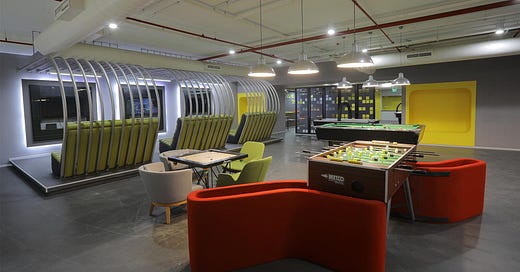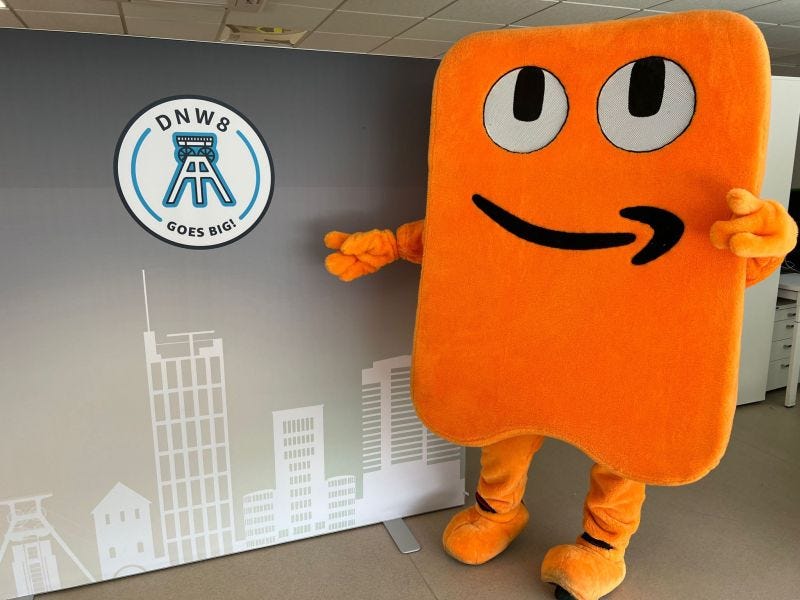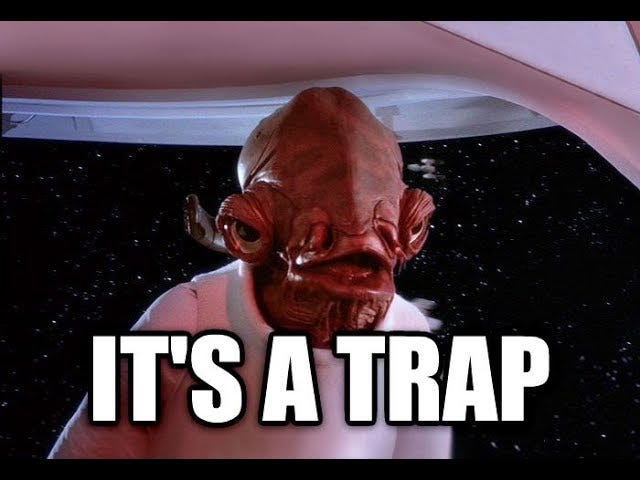The photo above is a break room within an Amazon operational facility. Note how hip and inviting this space feels. It is upbeat. It looks fun.
Let’s hold that thought.
Recently, I’ve found myself discussing workplace culture in several parallel discussions online and offline. It makes me think about something peculiar and unintentionally hilarious.
A brief story will illustrate.
In 2016, I joined Amazon’s operations network and found myself preparing to launch a state-of-the-art robotic warehouse in Manchester, UK. To prepare for this, my team were sent temporarily to a similar facility in New Jersey for a few weeks.
There, I was embedded in the facility’s inbound team and assigned an operations manager “battle buddy” to show me the ropes. We’ll call her Carla.
Carla’s persona was a perfect fit for the relentless pace of Amazon. She went about her job with hand-wringing urgency. Frantically alt-tabbing between the countless open windows and spreadsheets on her laptop before reaching some sort of conclusion. Then scurrying off for a two-minute conversation fragment with an employee. Then repeating the cycle. She was never still. Even when stationary, her fingers and toes tapped and fidgeted furiously.
Every half hour, with alarming consistency, she’d beeline it for the outdoor break area to chug down a cigarette. Nicotine was the last thing her tightly wired brain needed, to say nothing of blood pressure readings I imagine would have gotten her admitted for observation. But it seemed to be the only thing capable of calming her down.
Carla was in perpetual motion. Moving, shaking, barking, occasionally baring a few teeth with a grudging smile carrying more than a hint of menace.
In my time there, I would give her some advice on improving engagement with her 80-person team. She was turning over 40% of her people every month, with daily absence rates averaging more than 25%. This reflected disaffection and apathy. Her team and the broader operation felt as chaotic as Carla herself. She fit well with an unwell situation.
But in the early going, I needed to find my sea legs. So I self-censored and took my cues from Carla, doing my best to filter what I was absorbing. I spent much of my time trying to understand how abnormal the environment was, having no prior frame of reference.
One particular evening, there was a kerfuffle. I was standing in the area where managers stood, leaning over a raised desk as I pored through a series of web pages designed to teach me the technical details of inbound operations. Carla had referred me to this informal guide, which was the closest thing to training I was going to get.
Lost in thought, I barely noticed when she shouted at me over the din of spinning conveyors, desperate to get my attention. Seeing her expression, I would have assumed a busload of nuns was heading over a nearby cliff.
“You’ve been standing there too long. You’re going to get yelled at if you don’t get moving!”
What?
She wasn’t making any sense. I was learning my role. This involved not just pacing the shop floor like a hi-vis scarecrow, but understanding how stuff worked so I could support people. And at this moment, I was reading. So I continued.
But wrong as she was, Carla was right.
A few minutes later, I was approached by a stocky, bearded figure sporting cargo shorts, a Boston Bruins t-shirt, and heavily worn running shoes. He had his baseball cap turned backwards and was chewing on a gargantuan wad of bubble gum.
He looked stupefied. I didn’t know whether he was bewildered or high.
Assuming he was one of Carla’s employees, I asked how I could help.
“You can help by getting your ass moving. We’re not paying you to imitate a parking meter. Get out on the floor and manage.”
Of the many weird things I might have chanced onto my Amazon bingo card, getting castigated by a stranger for trying earnestly to learn my job was not among them.
“Hi, I’m Tony” was my response, my hand outstretched.
He shook it with a hand as firm as an oatmeal-fed amoeba, continuing his look of sheer bafflement. He didn’t give me his name. I still have no idea what it was. When I saw him again, I referred to him as “Chuck” because it just seemed to fit somehow.
I smiled wryly, glanced down my nose at him with eyes that said “choke yourself,” and closed my laptop. He knew I was new. I knew he was a moron. We understood one another.
I learned later he was one of the building’s senior operations managers.
The lesson was that looking busy mattered. Idleness would attract a negative presumption. The thing to do, it seemed, was to circulate with a faux sense of purpose, catastrophizing over hangnail-sized non-issues.
Sure, we were just putting stuff in boxes and sending it to people. But our energy needed to be more compelling. Like, say, dismounting a Higgins boat at Omaha Beach.
Observing the remainder of the shift, I noticed no one stood in one place for long. No one made idle chit-chat. Taking a smoke break was a tactic to escape line-of-sight.
The next day, I stayed off the shop floor so I could learn Amazon without Amazon’s agents hunting me.
A few days after that, the bulk of senior management team of that particular building got fired. Someone came in from Seattle. They all went into a meeting room. When they came out, they gathered their things and left the building.
The chaos, attitude, and frenetic urgency of its culture wasn’t enough to make it productive or maintain its quality control. Error rates had departed orbit. The operation was losing money.
It seemed like no coincident to me that a building run by headless chickens was underperforming. But the culture I observed there wasn’t unique. It was typical across Amazon.
Which brings us to the buried lede.
To get to my work area in that New Jersey warehouse, I had to walk a mile or so, passing through a cafeteria and near several outlying break areas. There were a dozen or so break rooms in the warehouse, along with a constellation of outdoor smoking zones.
To foreshadow a key point, the smoking areas were hives of conviviality while the indoor break rooms carried the vibe of a hospital waiting area.
This, despite the breakrooms having situated within them an armada of recreational artifacts. Air hockey tables. Ping pong tables. Pool tables. A table with a backgammon board built into it.
Many eons from now, when aliens excavate our remains and try to understand us, they’ll theorize that Amazon was a hive of recreational interplay.
But they’ll be wrong.
Because what I noticed in 2016 and throughout my tenure is that these recreational activities were mere ornaments. Unused.
As a new Amazonian, I looked upon them with a whimsical smile. Air hockey tables reinforced my belief that I’d joined a fun company with a loose and informal ethos. People didn’t wear suits to work. They wore sneakers and baseball caps and ratty t-shirts. And apparently they played air hockey.
Except they didn’t. I noticed within a couple days that they were literally caked with dust. Veteran employees seemed to understand something I didn’t.
One day, I approached an air hockey table, thinking if I started to play, someone would join me. A small band of employees from the stowing department were enjoying their breaks, flipping through their phones to see what was happening in the outside world. Maybe this was my moment to spark the revolution.
As I ambled toward the table with clear intent, I realized someone was watching me. It was Ernie. An inordinately tall associate with dark and frizzy mutton chops, gauges in his elongated earlobes, and a pair of Doc Martens resting below the rolled termini of Oasis-era stonewashed jeans. The day before, Ernie had taught me how to stow inventory. Today, he was trying to keep me alive.
As I looked up and caught Ernie’s gaze, he looked back at me pensively, a strained and squinted expression insisting I stop moving and pay attention. Almost imperceptibly, he wagged his chin left to right. I recognized this from the spy movie genre. He was warning me away from danger.
This telepathic nudge from a local denizen kept my hands off that air hockey table. To this day, I’m not certain what grim fate might have awaited. But I am grateful for Ernie’s intervention, which felt like a veteran inmate keeping a new fish from getting shivved.
But of course it all raised questions.
Why was no one playing with these things? If no one was playing with them, why did they exist?
In the years which followed, I deciphered the answers to these questions. The first clue on that journey of discovery was sitting right in front of me all along. It was at the bottom of every email glancing across the screen of the laptop I was supposed to be too frantically busy to open.
It was the meat in Amazon’s strapline sandwich, which I came to suspect was actually meatless.
“Work Hard. Have Fun. Make History.”
Amazon wants to be understood as a fun place to work. This traces back to its founding spirit and the founder himself, Jeff Bezos.
Among his many personality traits was a fun-loving spirit and an infectious mirth. Visitors to Amazon’s corporate offices usually heard his laugh from down the hall long before they saw him.
Bezos set a tone of fun which rippled out beyond corporate cubicle farms and into every corner of the company’s operations.
But if it wasn’t a false premise in the beginning, it has become one since. The “have fun” in Amazon’s tagline is at odds with the typical experience of working there.
Breaks are not nearly long enough for air hockey tournaments or 9-ball competitions. Break rooms are dead zones where employees keep to themselves, spending their precious minutes hydrating and surfing their phones, which is not permitted at their workstations.
Walking times to and from break areas are defined. There is no “sneaking an extra 5 minutes.” It’ll get noticed.
Because how employees spend their time is a managerial obsession. Woe betide the junior manager whose team performs slower than senior manager expectations.
Lava will spill downslope from Mount Finance, scorching all in its path. Even the thick soles of Ernie’s Doc Martens will liquify.
In principle, this makes sense. Crafting solid labor plans that commit the right manpower to meet customer demand without under-utilized people and machines is a core operational tenet at Amazon. Back when it offered the lowest prices possible, labor efficiency was a big part of why.
But like anything, it can be taken too far. Amazon’s cultural habit is to obsess over and control how employees use their time. Idleness is verboten, just as Chuck had made clear to me with his profane bleat.
The drive for productivity means employee performance is closely monitored and measured. Since every process in a warehouse requires at least one scan, there is an ocean of scan data to tell managers about productivity. Any time spent having fun, talking to a coworker, or using the bathroom is time not spent producing. Which means fewer units scanned in a space of time.
Taking a 15-minute liberty to play ping pong will result in a “slow” hour. Too much of this, and an employee will drop into the lower echelon of productivity, triggering unwanted attention. Though, as a plus, they will get access to longer conversations with managers.
But long before that, they’ll be braced and put under the heat lamp for time theft.
I worked full-time in five different Amazon warehouses and spent time in a couple dozen more. I can count on one hand the number of times I witnessed an hourly employee making use of recreational equipment.
And yet, the equipment continues to be featured in Amazon facilities. In fact, trying to launch a building without installing these things is harder than scaling Everest. Suggesting we leave them out of a launch plan was enough to get me hauled onto a call with a council of ironically underemployed bureaucrats to explain myself.
When I said “because no one uses them,” it was as though I’d suggested sending out a TPS report without a new cover sheet. Many a pearl was clutched. Shocked onlookers froze in mid-stride, as though suspended by Medusa’s gaze. The sound of a vinyl record scratching gave way to the shrill cries of terrified children.
I had committed an act of corporate heresy. Admitting openly that no one has fun with the fun equipment is as verboten as having fun with it.
It’s like saying the contents of the briefcase in Pulp Fiction are just a contrivance to alight an otherwise grim narrative. It’s like living in Manchester and telling your American friends it rains all the time.
Some things, we just don’t say. Even if everyone knows they are obvious.
But this doesn’t explain why a company obsessed with perpetual motion would waste money on something that sits idle.
There’s a reason why Amazon continues to have air hockey tables. Maybe even two reasons beyond the banal impulse to litter empty space with overpriced warehouse kitsch.
Reason number one is that Amazon must deny what it cannot admit. Not to itself, not to its employees, not to its corporate overlords, not to the communities which host it workforces and buildings, and certainly not to the wider world.
It cannot admit that “Have Fun” is just propaganda. Window dressing. Image maintenance.
Cafeterias stocked with multi-colored chairs reminiscent of a middle school classroom, playful decor, and recreational equipment help sustain a fiction which serves Amazon’s interests by helping it be seen as a domain of good natured merriment. And not be seen as a merciless profit foundry melting anything of value to press a few more coins for shareholders and executives.
The propaganda effort is represented not only by Amazon’s PR brigade, but by a walking orange rectangle called Peccy, who is supposed to be the company’s “peculiar” mascot, but is really just an ambulatory cringe beacon.
I’m not going to tell you no fun is had at Amazon. Here’s a picture of me and my senior operations managers two years ago today, dressed as The Beatles for the launch of our new warehouse in Liverpool.
But the fun at Amazon happens despite its prevailing culture, not because of it. Usually, it happens among salaried employees who have been licensed to make untracked trips to the bathroom. Who have more latitude in how they structure their activity.
Among hourly employees, creating fun and driving positive culture is nigh on impossible.
The work is mostly stationary and isolating. There is no time for people to talk, to learn about one another, to bond. This prevents the formation of shared identity, sense of belonging, and common purpose. This is why they don’t talk to one another on breaks. They don’t know one another.
Any attempt to change that must fit with Amazon’s second-by-second workplace design, or it will invite professional wrath. A financial analyst will notice, a target reticle will be placed upon an individual, and a manager will begin to hunt them.
Don’t get me wrong. Culture and positivity are difficult to create in any commercial environment. But Amazon’s tireless pursuit of every possible nickel of revenue pervades every aspect of its operational culture.
It is a thick barrier to fun. Because Amazon doesn’t see the bigger picture, that loosening the bridle would likely get employees to gallop a little faster on their own, without constant need of a riding crop.
You want to extend your break 5 minutes to finish a game? Surely you jest. We’re not paying you to impersonate a parking meter.
Which brings me to the second reason Amazon continues to install recreational equipment in warehouses.
Because it’s a great way to flush out the slackers. To tempt them into exposing the laziness lurking in their sluggish, callow souls.
Once we know who they are, we can figure out how to get rid of them and replace them with people who work faster. Who appreciate the privilege of a job enough to bring a gladiatorial focus with them to work every day.
Meantime, the air hockey tables will depreciate slower from disuse, thereby fulfilling their image-boosting raison d’etre for longer. When the warehouse finally closes, they’ll still be new enough to be donated, adding the lacquer of social responsibility to our manicured image.
Now, I know what you’re thinking.
Man, that is a sarcastic take. In fact, it’s a cynical take. And you’re right.
But that doesn’t make it wrong.
But the real whopper is that this is the way many Amazonians actually think about the ping pong tables in their buildings. It’s hard to overstate how psychically fractured this particular say/do gap leaves people. Those who take Amazon at its word end up wrongly believing that a ping pong table is what it seems.
But it isn’t.
It is an evolved form of managerial chicanery. It is the pit lined with poison-tipped punji stakes Ernie was warning me about.
Fake fun isn’t just a trap for employees. It’s a trap for companies who believe they can fudge their way to a strong culture. They find out, as Amazon continues to notice, that while resourcing a workplace for positivity carries a cost, it’s a lot more expensive to re-hire your workforce because they keep quitting.
There are not enough workers in the American labor pool to continue feeding Amazon’s turnover rates. Shareholders haven’t seemed to notice this yet. But they will, when it becomes prohibitively expensive to keep the business going after its reputation as a contemporary salt mine reaches a societal tipping point.
Window dressing is just one of myriad pathologies infecting business that seek culture creation because of what it can do for them, while remaining jaundiced about what it might do to them.
This sort of thing evinces an internal view of people as an impediment rather than a source of vitality, identity, and joy in the workplace.
But like values and principles, air hockey tables only make things worse for workers when they exist not for the sake of fun, but for the sake of creating the impression of fun. The injury runs deeper, piercing honesty and trust.
Amazon’s culture reflects an incentive for the appearance of fun, but not fun itself. Or more precisely, fun as directed and controlled by the company.
Which, of course, is no fun at all.
TC is a writer with interest and expertise in organizational leadership. He previously served in a director-level role in Amazon operations.















Lots of truth in this. Amazon has a “peculiar” culture but that is too often cover for issues like you describe. Like all too many companies their actions speak louder than their words. Internally focused on small things and talking about the big things.